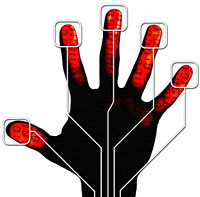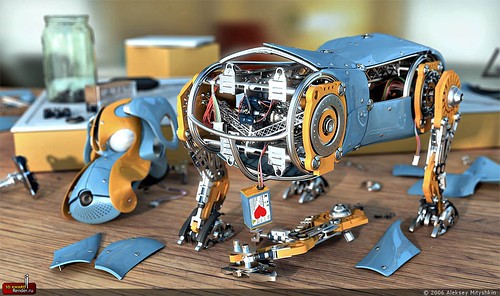 "QUANTUM SHOT" #213
"QUANTUM SHOT" #213Article by guest blogger The Free Geek
Today we welcome a fellow blogger from the "Free Geekery" website. Free Geekery focuses on discounts and freebies for the discerning nerd. Its resident blogger, The Free Geek, writes regularly about gadgetry, computer accessories, gaming, software, health, and vacationing geared toward the money-savvy geek looking to save a few bucks. The following tongue-in-cheek article on how it's possible (even today) to become a human machine (not that anyone would want to...) is his first appearance on Dark Roasted Blend. (see original here) We welcome your comments about the article and feedback on co-blogging format.
The DIY Guide to Becoming a (Real) Cyborg
A scientific duo at Tel-Aviv University discovered this past month that the injection of a chemical stimulant into an artificial culture of live neurons at crucial points in time could create an environment that can store multiple rudimentary memories. (which is considered to be a critical step towards cyborg-like integration of living material into memory chips.) While many individuals might be disturbed about the fact that artificial intelligence has become a reality, advocates might applaud the scientists' conclusion that chemical stimulation may be crucial to learning and memory formation in living organisms. Still other individuals might wonder if a middle ground in this debate about artificial intelligence is possible, or if any semblance of humor can be injected into a serious subject to lighten the atmosphere.

(3D art by: Pawel Hynek, CGSociety)

Individuals who resist the artificial intelligence development often believe that this technology bodes nothing but evil, especially if research falls into nefarious hands. Others are grateful for this research. Witness Jesse Sullivan, an electrician who accidentally touched an active cable that contained 7,000-7,500 volts of electricity in 2001 and, as a result, lost both arms at the shoulder. Since then, he's become the recipient of a 'bionic arm' created by scientists at the Rehabilitation Institute of Chicago. His experience, while truly unique, may help others lead active lives in the near future with these life-like prostheses.
The middle ground, perhaps, comes when society realizes that progress is inevitable, "evil" may exist alongside altruism, and — while hindsight is 20/20 — a little foresight and humor can help to create a gray area for a future where machines may outsmart a Mensa member. Even if you live on a limited budget, you can try a few of the following ideas on for size. Who knows? You might decide that you enjoy being less human and more resistant to all the limitations that the flesh endures.
1. RFID Implants


Perhaps the closest any average individual can come to cyborg-like transformation is through an RFID (Radio Frequency ID) transplant. When Amal Graafstra implanted an RFID chip into his left hand in 2005, he didn't break any laws, but he did raise some eyebrows. Since 2005, Graafstra's implants (now one in each hand), have ceased to engender shock. At first, many people wondered why Graafstra would consent to implant a chip in his hand merely to gain access to his locked doors without a key. Now, people agree to implants to gain access to nightclubs.
Many individuals have discovered that when there's a will, there's a way to accomplish the task at hand (so to speak). Mikey Sklar, a third-generation geek, "chipped" his own hand for only $105.49. If you grow woozy at the thought of self-surgery, the price of a tattoo artist who can commit the deed would be considerably less expensive than the cost of a surgeon.
With that said, the price of healing an infection could ravage your savings when you implant a chip without professional guidance. Do your research first, as you'll learn that the antennae needs to face forward unless you want to learn how to become a contortionist as well as a semi-cyborg. Also, you might discover that phidgets (physical widgets) have emerged as low-security and low-price alternatives to RFID chips.

(3D art by: Luciano Honorato)
2. Watch the Future
If you've managed to keep all your limbs and if implants turn you off, you can still become somewhat bionic with your accessories. For example, you can find watches that serve dual purposes and that will help minimize brain usage. Take the PayPass-enabled wristwatch created by Turkey's Garanti Bank and MasterCard. You can tell time and watch your credit card debt grow simultaneously. Or, you might lean toward the sexually unbiased design contained in the Infinity Watch Concept that includes MP3 and Video. You can sit around and watch your watch.

3. Become One with Your Computer
If you want to become the computer rather than just use the computer, the i-glasses PC/SVGA™ offer a portable, affordable, high resolution, computer monitor that you can wear. This unit supports 3D computer imaging when you connect it to common PC sources including laptops and some PDAs. This monitor fits comfortably, as it weighs only 7 ounces and is fully adjustable. Not only can you receive images comparable to a 70-inch monitor viewed from a distance of 13 feet, you can also enjoy sound through built-in headphones.


If you can't afford the minimum $899.00 for the i-glasses, you can opt for the Virtual FX 3D converter. This pair of glasses converts any flat screen images into stereoscopic three-dimensional images when you wear them. A microprocessor supplies the power to change your vision for $99.00 on sale.

4. Leap Tall Buildings in a Single Bound
Now that you've purchased the watch and the head monitor, you might want to add a little bounce to your walk with Powerizers. If you're an adult and somewhat athletically inclined, you can lay claim to the ability to jump up to 6 feet in the air and to take running strides up to 9 feet in length. You'll pay for this ability, however, as a pair of Powerizers currently costs $329.99 plus shipping and handling if you order them online. A physically fit bill collector who owns a pair of these shoes might fall under the "evil" category.


If you can't afford the Powerizers, you can get your hands on a Superman costume for $32.19. Then, you can claim to leap buildings at a single bound. Additionally, you don't need to prove yourself because you're Superman, a man of his word (this theory also applies to any Wonder Women).
5. Become a Human Transformer
 Fabric patches developed by engineers at the Massachusetts Institute of Technology can help you to create a variety of "smart" or environment-sensing objects. Each patch contains a microprocessor and memory plus either a radio transceiver, a sensor, a microphone, batteries, or a display. The circuit board inside each patch is coated with a hard transparent resin to keep it waterproof. It's then padded with a thin layer of foam and encapsulated in a chosen fabric. You can populate each patch with a variety of components, from Bluetooth transmitters to a cut-down PC motherboard.
Fabric patches developed by engineers at the Massachusetts Institute of Technology can help you to create a variety of "smart" or environment-sensing objects. Each patch contains a microprocessor and memory plus either a radio transceiver, a sensor, a microphone, batteries, or a display. The circuit board inside each patch is coated with a hard transparent resin to keep it waterproof. It's then padded with a thin layer of foam and encapsulated in a chosen fabric. You can populate each patch with a variety of components, from Bluetooth transmitters to a cut-down PC motherboard.To make a long story short, you can teach your wallet to remind you to bring along an umbrella, or your wall hanging can tell you if someone's trying to log onto your wireless network. As these patches evolve, you can create clothing that will act as an eyepatch monitor or a keyboard that flexes with the palm of your hand.
Based upon the theory that technology can be used for intimate play, Jennifer Chowdhury created patches that transform people into video game controllers, encouraging couples to touch each other as they progress through a game. The game will result either in more intimate play or in a rivalry that will challenge your best intentions. These patches, by the way, are installed in undergarments, so you need to convince someone to strip before you can begin to play. Come to think of it, you don't need technology for this activity...

(3D art by: Yougor Gavrikov, Render.ru)
6. Talk to the Wired Hand
 The Data Glove, or ShapeHand™, is a portable, lightweight, hand motion capture system composed of flexible ribbons that capture hand and finger motion. ShapeHand's flexible sensors are not physically built into a glove, so you can attach this technology to virtually any glove and hand size to export hand motion data into gaming engines and other enterprises.
The Data Glove, or ShapeHand™, is a portable, lightweight, hand motion capture system composed of flexible ribbons that capture hand and finger motion. ShapeHand's flexible sensors are not physically built into a glove, so you can attach this technology to virtually any glove and hand size to export hand motion data into gaming engines and other enterprises.You can go further with the ShapeHandPlus™, where the data glove is integrated with arm tracking ShapeTape. ShapeHandPlus tracks complete hand and arm movements and poses, including contortions you create when you implant your RFID antennae the wrong way.
You know that when you need to call or email for a price, as you do with this technology, that the price probably lands light-years beyond any normal budget. But, you can build your own DataGlove with a regular glove and raw materials found at any local RadioShack. A rough upper-limit cost for this glove could reach about $500; but if you have some of the components lying around (like an A to D converter), you could save at least $90.00.
7. Become a Vehicle for Change
While hilarious, this gadget might be lifesaving if you're a cyclist. Indicatears allow you to turn yourself into a vehicle of sorts as you turn your ears into turn signals. The price is right - $5.95 for a pair - and they operate on simple batteries instead of high technology. Just don't press the right and left Indicatear buttons at the same time, or you might confuse those individuals who lurk behind you.


If you add rearview mirrors that you can attach to your glasses ($13.95), you'll be ready to take on any traffic. The mirrors could be mounted on the outside of the glasses to blind your enemies on sunny days. All you need now are some fuzzy dice to wear around your neck.
8. Dress Accordingly
If the iJacket and iSuit don't represent your personality, you might go for a variety of shirts and T-shirts that can alter the way you look and feel. One example includes the Sound Activated Illuminated T-shirt ($48.65) that reacts to sound with bars that mimic an equalizer. The bars keep rhythm with any music, so you can stand still and just pretend like you're dancing. The Animated Retro Table Tennis shirt is a bit more complex, yet it can make you appear simple or make you disappear altogether if you're in a dark room. This T-shirt ($24.99), like the previous one, runs on a battery pack.


On days when you don't feel loved, you can wear the Hug Shirt. Embedded sensors and electronics react to a wireless mobile phone message that allows you to feel the physical closeness of a distant loved one as the shirt simulates the sensation of a hug. This shirt was developed by CuteCircuit, a company that specializes in wearable computing, including kinetic clothing that reacts to the wearer's activities and mood. These items are in test mode, and are not yet ready for sale.
While this technology can be fun, it can also be used for covert operations. Two students in Singapore developed textiles that use Electrochromism so that a uniform can blend into any surrounding. This invention is far more mobile than traditional attempts at camouflage.

(3D art by: Aleksey Mityshkin, Render.ru)
9. Refuse to Live with Your Genes
 If you want to shoot golf like Tiger Woods, you'll need laser surgery that enables 20/15 vision. This means that Tiger can see objects at 20 feet that a normal person would see at 15 feet. If you can't afford laser surgery ($1,000–$2,500 per eye), then try contact lenses like former baseball hero Mark McGwire. McGwire's lenses improved his vision to 20/10, so he could see objects at 20 feet that a normal person would see at 10 feet. Of course, McGwire was also using a legal, performance-enhancing steroid precursor, androstenedione, when he obliterated the record for the number of home runs in a season back in 1998. So it's a toss-up as to whether the lenses worked or not.
If you want to shoot golf like Tiger Woods, you'll need laser surgery that enables 20/15 vision. This means that Tiger can see objects at 20 feet that a normal person would see at 15 feet. If you can't afford laser surgery ($1,000–$2,500 per eye), then try contact lenses like former baseball hero Mark McGwire. McGwire's lenses improved his vision to 20/10, so he could see objects at 20 feet that a normal person would see at 10 feet. Of course, McGwire was also using a legal, performance-enhancing steroid precursor, androstenedione, when he obliterated the record for the number of home runs in a season back in 1998. So it's a toss-up as to whether the lenses worked or not.But, the lenses currently are available to the general public, along with built-in colors like amber (best for fast-moving sports like baseball and soccer because it blocks out annoying blue light and accentuates the reds) and gray-green (best for slow-moving sports, such as golf, that are played in the bright sunlight). They cost no more than traditional lenses, which average about $20 per pair when the price is right.
Either way, you get the point. Why live with your genetic makeup when you can enhance your body? The list goes on: Instead of hearing aids, you can gain access to digital signal processors, little gadgets that fit in your ear and that can be programmed to pick up conversations from across a crowded room. You can also take calcium to avoid a genetic tendency toward osteoporosis. Or, you can get a hair transplant if you think you're going bald.
The line is being drawn, however, between what appears to be life-enhancing products and products that could turn great athletes into uber-competitors. Eventually, if you've replaced a body part, you may not be eligible to compete in the Olympics. But, you may be able to communicate telepathically, and that ability may be more important in the long run.
10. Get a Futuristic Life
If you continue to carry out your transformation research with earnest, you eventually will encounter Kevin Warwick, a professor at the University of Reading and the first human cyborg. Warwick carried out a series of experiments that involved the neuro-surgical implantation of a device into the median nerves of his left arm. This device linked his nervous system directly to a computer so that he could assess the latest technology for use with the disabled. He also has been successful with the first extra-sensory (ultrasonic) input for a human and with the first purely electronic communication experiment between the nervous systems of two humans — actually, between Warwick and his wife, Irene.
His next project involves the implant of a computer into his brain to experiment with memory alterations and to record those memories, perhaps dreams, to play them back. This technology may make thought communication possible, a means to enhance a sixth sense that goes beyond anything humanly possible. In other words, Warwick is trying to replace Bluetooth technology with the human nervous system.
While you may suffer through horrible nightmares about machines that take over the world, progress in using technology to help others is far more pronounced. But, don't let this news lull you into thinking that you can battle a cyborg without technological help — or even without laughter. After all, how many cyborgs would dare touch you when you signal a left and right turn with your ears at the same time while wearing fuzzy dice, a pair of Powerizers, and a cape?

(3D art by: Rudolf Herczog)
Article by the Free Geek, Free Geekery for Dark Roasted Blend.
(want to become a co-blogger? write to us, see guidelines here)
Permanent Link...

Category: Technology,Gadgets
Related Posts:
Robotics News from Japan, Future of Personal Computing
Dark Roasted Blend's Photography Gear Picks:








0 comments:
Post a Comment